Project Cost Management: Analysis of Estimation Techniques - PM 6
VerifiedAdded on 2022/08/21
|7
|1116
|30
Report
AI Summary
This report delves into the critical aspects of project cost management, beginning with the definition of essential project cost terms such as direct, indirect, fixed, variable, and sunk costs. It then provides a comparative analysis of three prominent cost estimation techniques: analogous, parametric, and bottom-up estimation, highlighting their respective advantages and disadvantages. The report also addresses key issues that can arise in project cost estimation, including forecasting failures, resource constraints, incorrect data, and the challenges of budgeting in dynamic project environments. The provided report is a valuable resource for students seeking to understand the complexities of project cost management and improve their skills in this area. This report is available on Desklib, which offers a wide range of study materials and resources, including past papers and solved assignments, to help students excel in their academic pursuits.
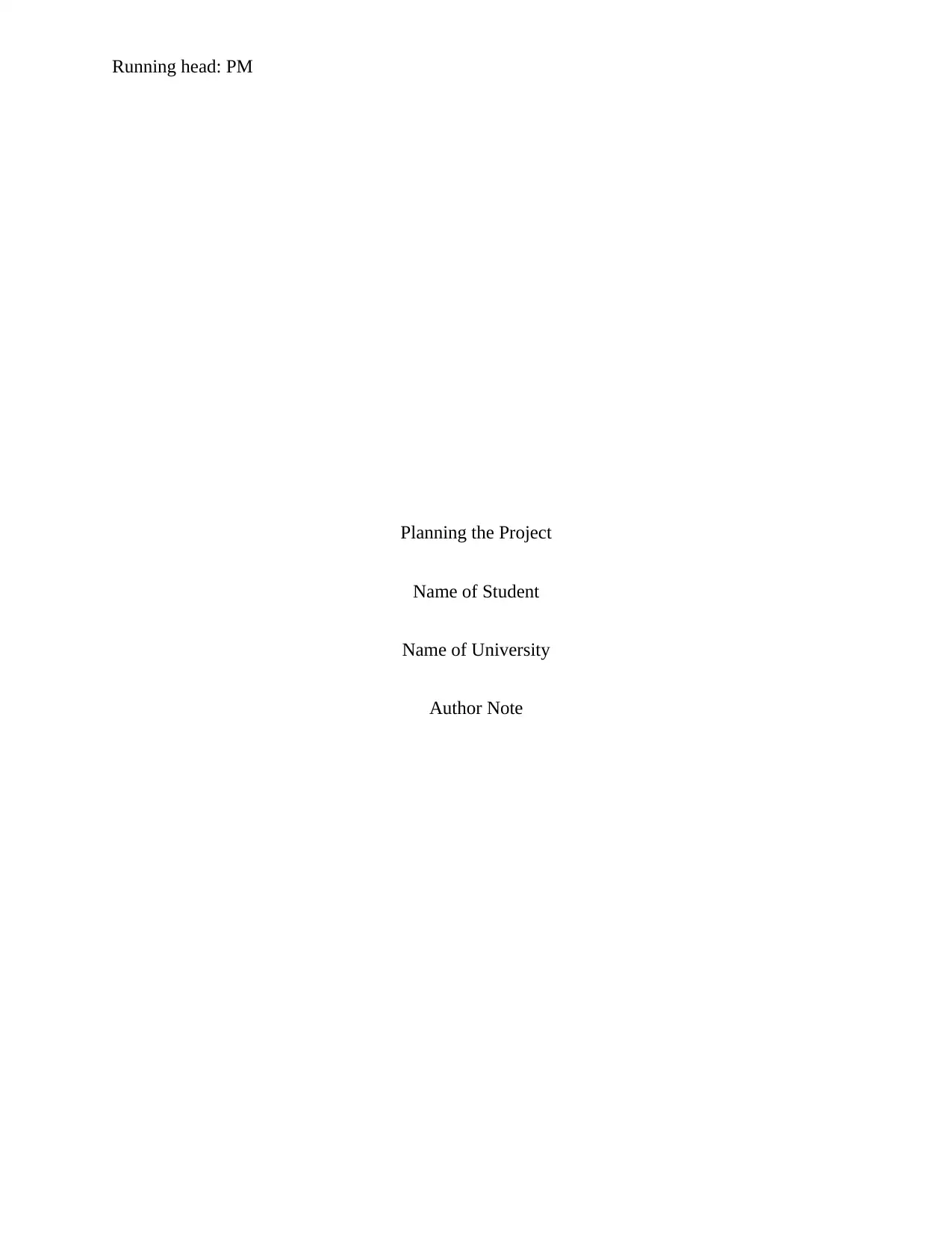
Running head: PM
Planning the Project
Name of Student
Name of University
Author Note
Planning the Project
Name of Student
Name of University
Author Note
Paraphrase This Document
Need a fresh take? Get an instant paraphrase of this document with our AI Paraphraser
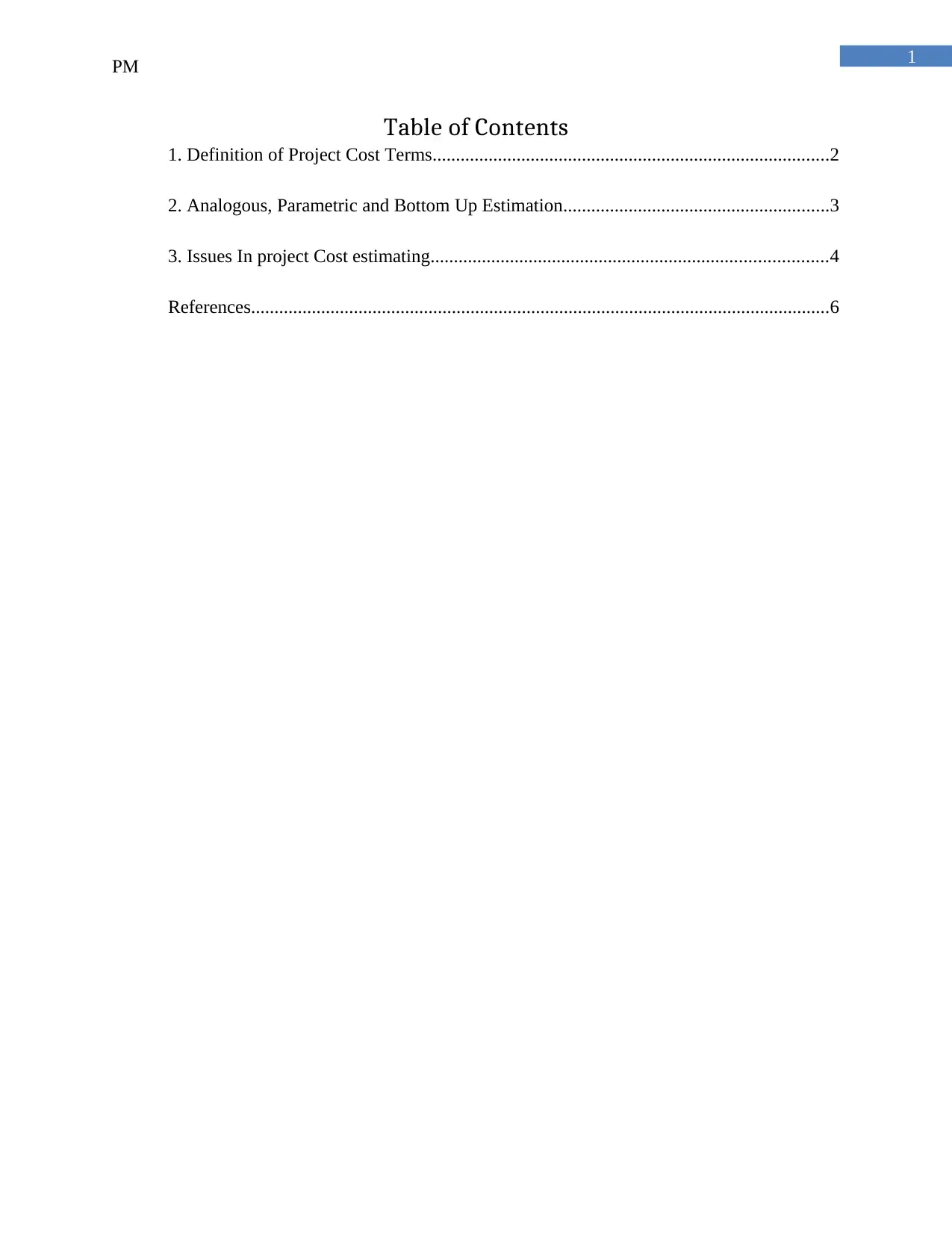
1
PM
Table of Contents
1. Definition of Project Cost Terms.....................................................................................2
2. Analogous, Parametric and Bottom Up Estimation.........................................................3
3. Issues In project Cost estimating.....................................................................................4
References............................................................................................................................6
PM
Table of Contents
1. Definition of Project Cost Terms.....................................................................................2
2. Analogous, Parametric and Bottom Up Estimation.........................................................3
3. Issues In project Cost estimating.....................................................................................4
References............................................................................................................................6
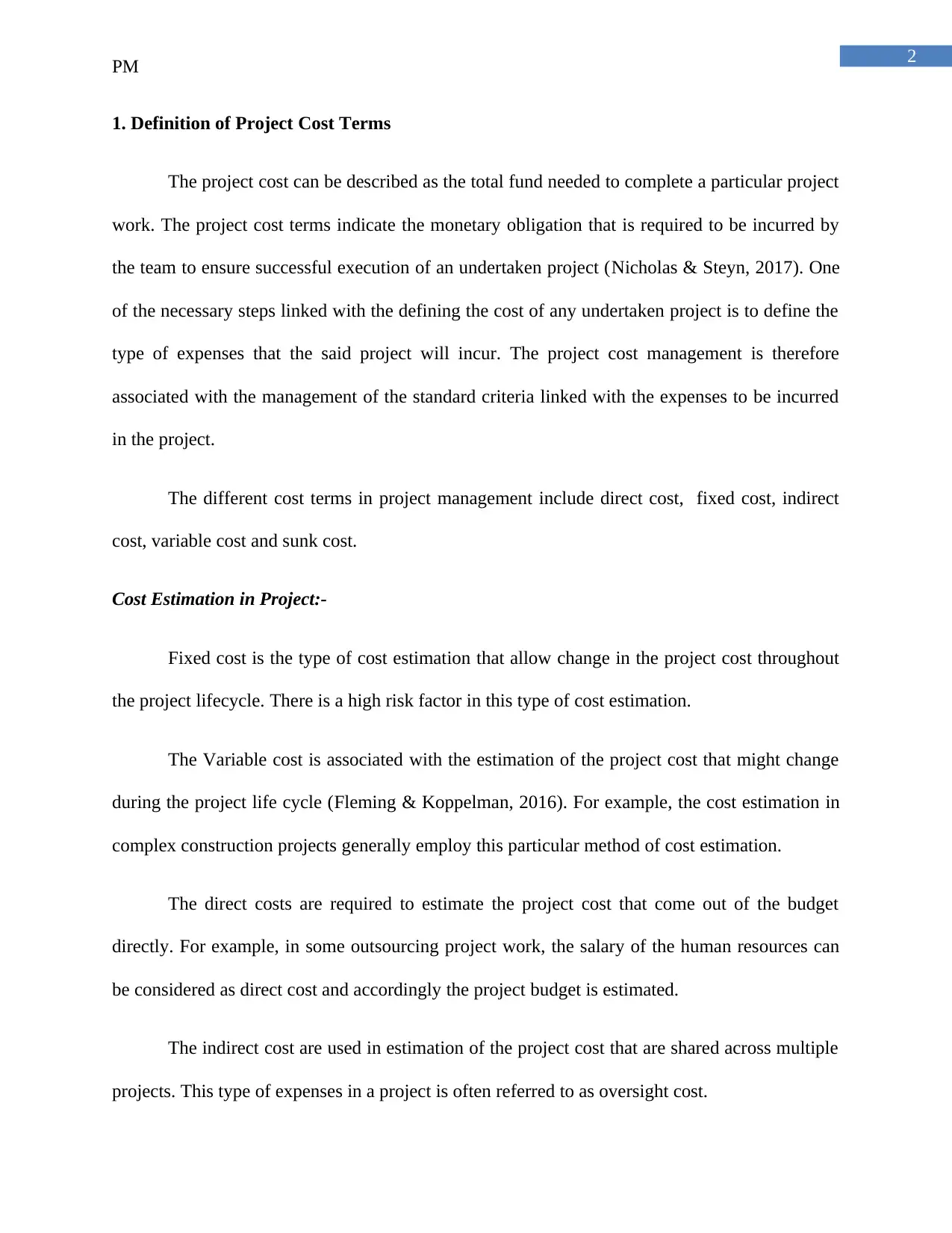
2
PM
1. Definition of Project Cost Terms
The project cost can be described as the total fund needed to complete a particular project
work. The project cost terms indicate the monetary obligation that is required to be incurred by
the team to ensure successful execution of an undertaken project (Nicholas & Steyn, 2017). One
of the necessary steps linked with the defining the cost of any undertaken project is to define the
type of expenses that the said project will incur. The project cost management is therefore
associated with the management of the standard criteria linked with the expenses to be incurred
in the project.
The different cost terms in project management include direct cost, fixed cost, indirect
cost, variable cost and sunk cost.
Cost Estimation in Project:-
Fixed cost is the type of cost estimation that allow change in the project cost throughout
the project lifecycle. There is a high risk factor in this type of cost estimation.
The Variable cost is associated with the estimation of the project cost that might change
during the project life cycle (Fleming & Koppelman, 2016). For example, the cost estimation in
complex construction projects generally employ this particular method of cost estimation.
The direct costs are required to estimate the project cost that come out of the budget
directly. For example, in some outsourcing project work, the salary of the human resources can
be considered as direct cost and accordingly the project budget is estimated.
The indirect cost are used in estimation of the project cost that are shared across multiple
projects. This type of expenses in a project is often referred to as oversight cost.
PM
1. Definition of Project Cost Terms
The project cost can be described as the total fund needed to complete a particular project
work. The project cost terms indicate the monetary obligation that is required to be incurred by
the team to ensure successful execution of an undertaken project (Nicholas & Steyn, 2017). One
of the necessary steps linked with the defining the cost of any undertaken project is to define the
type of expenses that the said project will incur. The project cost management is therefore
associated with the management of the standard criteria linked with the expenses to be incurred
in the project.
The different cost terms in project management include direct cost, fixed cost, indirect
cost, variable cost and sunk cost.
Cost Estimation in Project:-
Fixed cost is the type of cost estimation that allow change in the project cost throughout
the project lifecycle. There is a high risk factor in this type of cost estimation.
The Variable cost is associated with the estimation of the project cost that might change
during the project life cycle (Fleming & Koppelman, 2016). For example, the cost estimation in
complex construction projects generally employ this particular method of cost estimation.
The direct costs are required to estimate the project cost that come out of the budget
directly. For example, in some outsourcing project work, the salary of the human resources can
be considered as direct cost and accordingly the project budget is estimated.
The indirect cost are used in estimation of the project cost that are shared across multiple
projects. This type of expenses in a project is often referred to as oversight cost.
⊘ This is a preview!⊘
Do you want full access?
Subscribe today to unlock all pages.

Trusted by 1+ million students worldwide
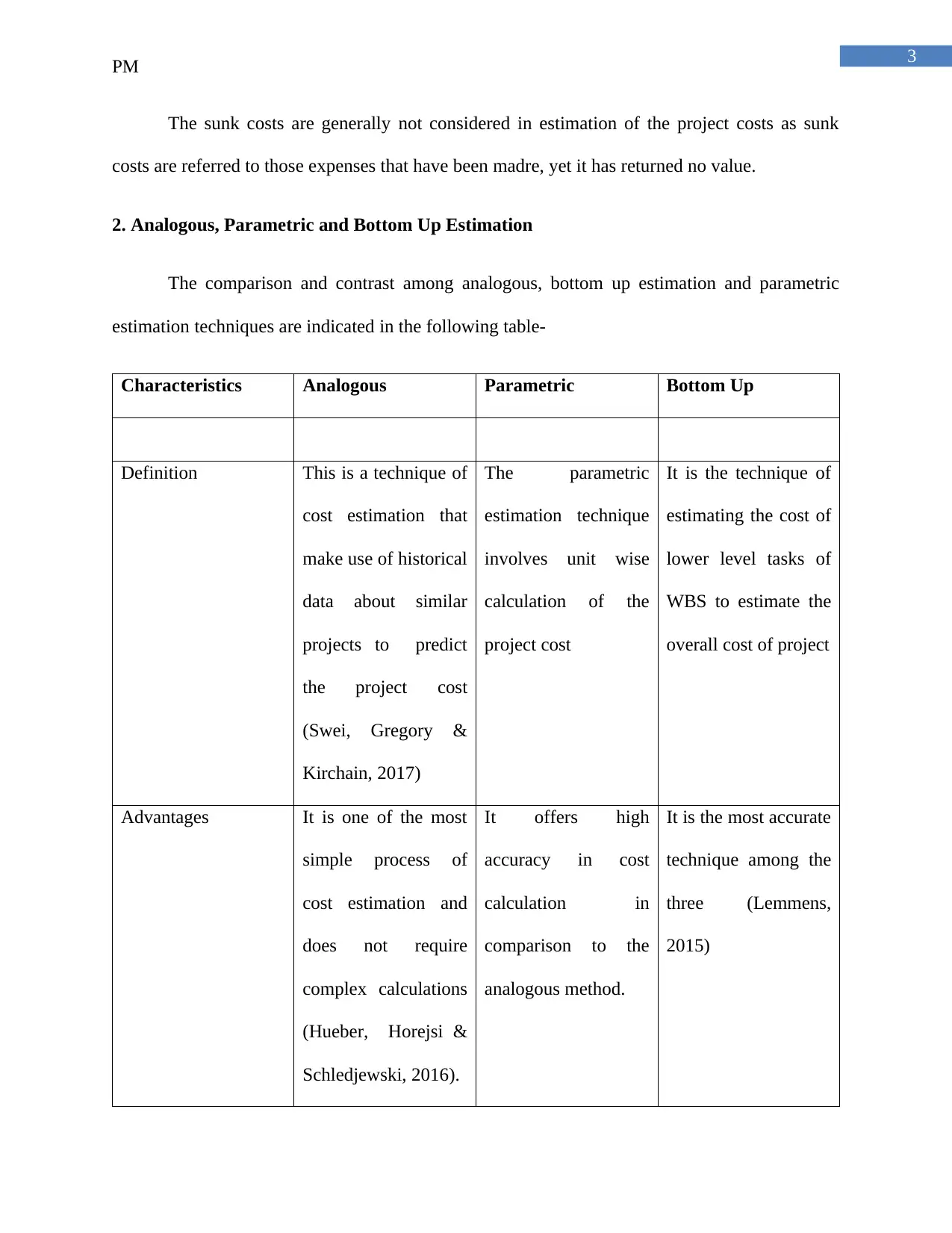
3
PM
The sunk costs are generally not considered in estimation of the project costs as sunk
costs are referred to those expenses that have been madre, yet it has returned no value.
2. Analogous, Parametric and Bottom Up Estimation
The comparison and contrast among analogous, bottom up estimation and parametric
estimation techniques are indicated in the following table-
Characteristics Analogous Parametric Bottom Up
Definition This is a technique of
cost estimation that
make use of historical
data about similar
projects to predict
the project cost
(Swei, Gregory &
Kirchain, 2017)
The parametric
estimation technique
involves unit wise
calculation of the
project cost
It is the technique of
estimating the cost of
lower level tasks of
WBS to estimate the
overall cost of project
Advantages It is one of the most
simple process of
cost estimation and
does not require
complex calculations
(Hueber, Horejsi &
Schledjewski, 2016).
It offers high
accuracy in cost
calculation in
comparison to the
analogous method.
It is the most accurate
technique among the
three (Lemmens,
2015)
PM
The sunk costs are generally not considered in estimation of the project costs as sunk
costs are referred to those expenses that have been madre, yet it has returned no value.
2. Analogous, Parametric and Bottom Up Estimation
The comparison and contrast among analogous, bottom up estimation and parametric
estimation techniques are indicated in the following table-
Characteristics Analogous Parametric Bottom Up
Definition This is a technique of
cost estimation that
make use of historical
data about similar
projects to predict
the project cost
(Swei, Gregory &
Kirchain, 2017)
The parametric
estimation technique
involves unit wise
calculation of the
project cost
It is the technique of
estimating the cost of
lower level tasks of
WBS to estimate the
overall cost of project
Advantages It is one of the most
simple process of
cost estimation and
does not require
complex calculations
(Hueber, Horejsi &
Schledjewski, 2016).
It offers high
accuracy in cost
calculation in
comparison to the
analogous method.
It is the most accurate
technique among the
three (Lemmens,
2015)
Paraphrase This Document
Need a fresh take? Get an instant paraphrase of this document with our AI Paraphraser
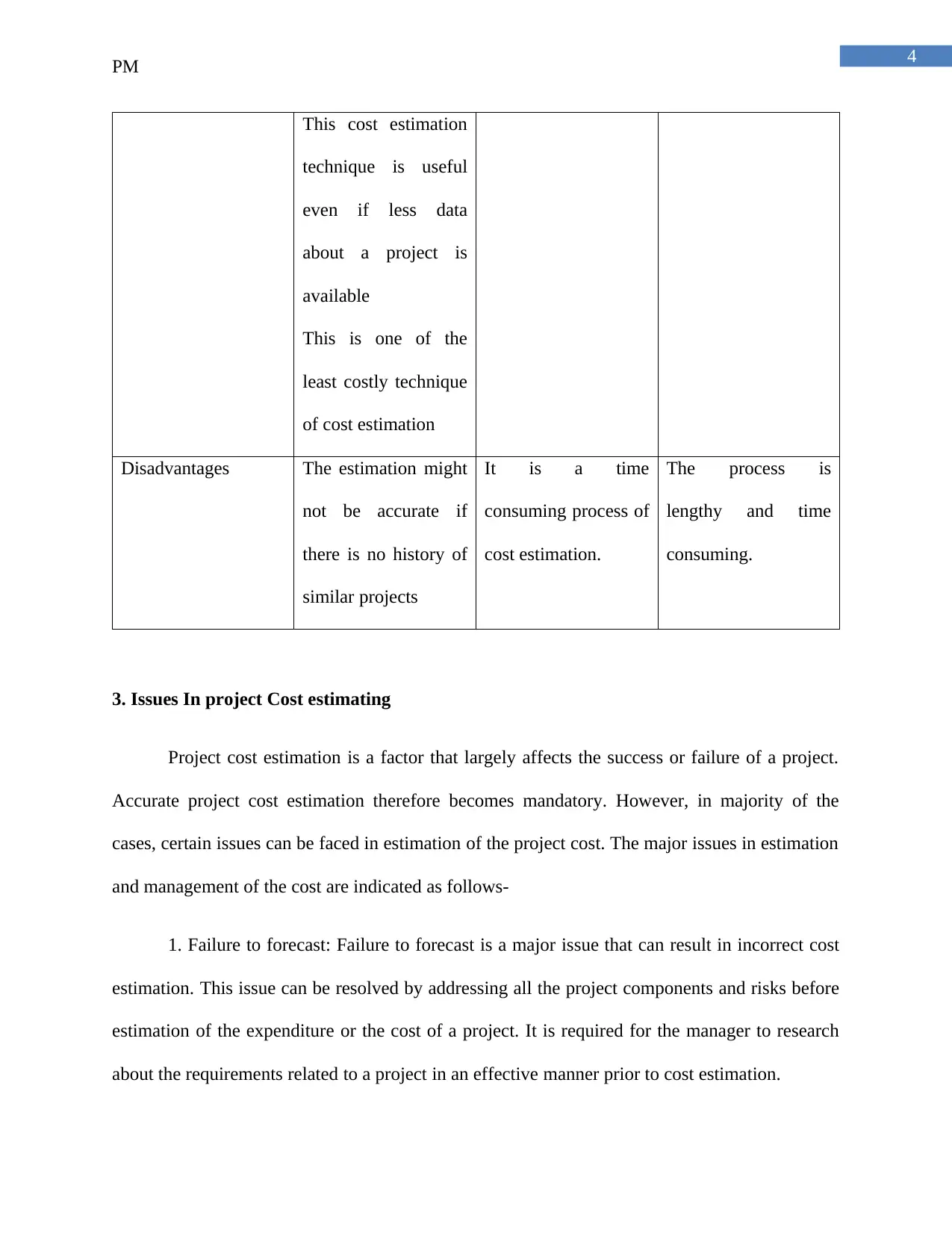
4
PM
This cost estimation
technique is useful
even if less data
about a project is
available
This is one of the
least costly technique
of cost estimation
Disadvantages The estimation might
not be accurate if
there is no history of
similar projects
It is a time
consuming process of
cost estimation.
The process is
lengthy and time
consuming.
3. Issues In project Cost estimating
Project cost estimation is a factor that largely affects the success or failure of a project.
Accurate project cost estimation therefore becomes mandatory. However, in majority of the
cases, certain issues can be faced in estimation of the project cost. The major issues in estimation
and management of the cost are indicated as follows-
1. Failure to forecast: Failure to forecast is a major issue that can result in incorrect cost
estimation. This issue can be resolved by addressing all the project components and risks before
estimation of the expenditure or the cost of a project. It is required for the manager to research
about the requirements related to a project in an effective manner prior to cost estimation.
PM
This cost estimation
technique is useful
even if less data
about a project is
available
This is one of the
least costly technique
of cost estimation
Disadvantages The estimation might
not be accurate if
there is no history of
similar projects
It is a time
consuming process of
cost estimation.
The process is
lengthy and time
consuming.
3. Issues In project Cost estimating
Project cost estimation is a factor that largely affects the success or failure of a project.
Accurate project cost estimation therefore becomes mandatory. However, in majority of the
cases, certain issues can be faced in estimation of the project cost. The major issues in estimation
and management of the cost are indicated as follows-
1. Failure to forecast: Failure to forecast is a major issue that can result in incorrect cost
estimation. This issue can be resolved by addressing all the project components and risks before
estimation of the expenditure or the cost of a project. It is required for the manager to research
about the requirements related to a project in an effective manner prior to cost estimation.
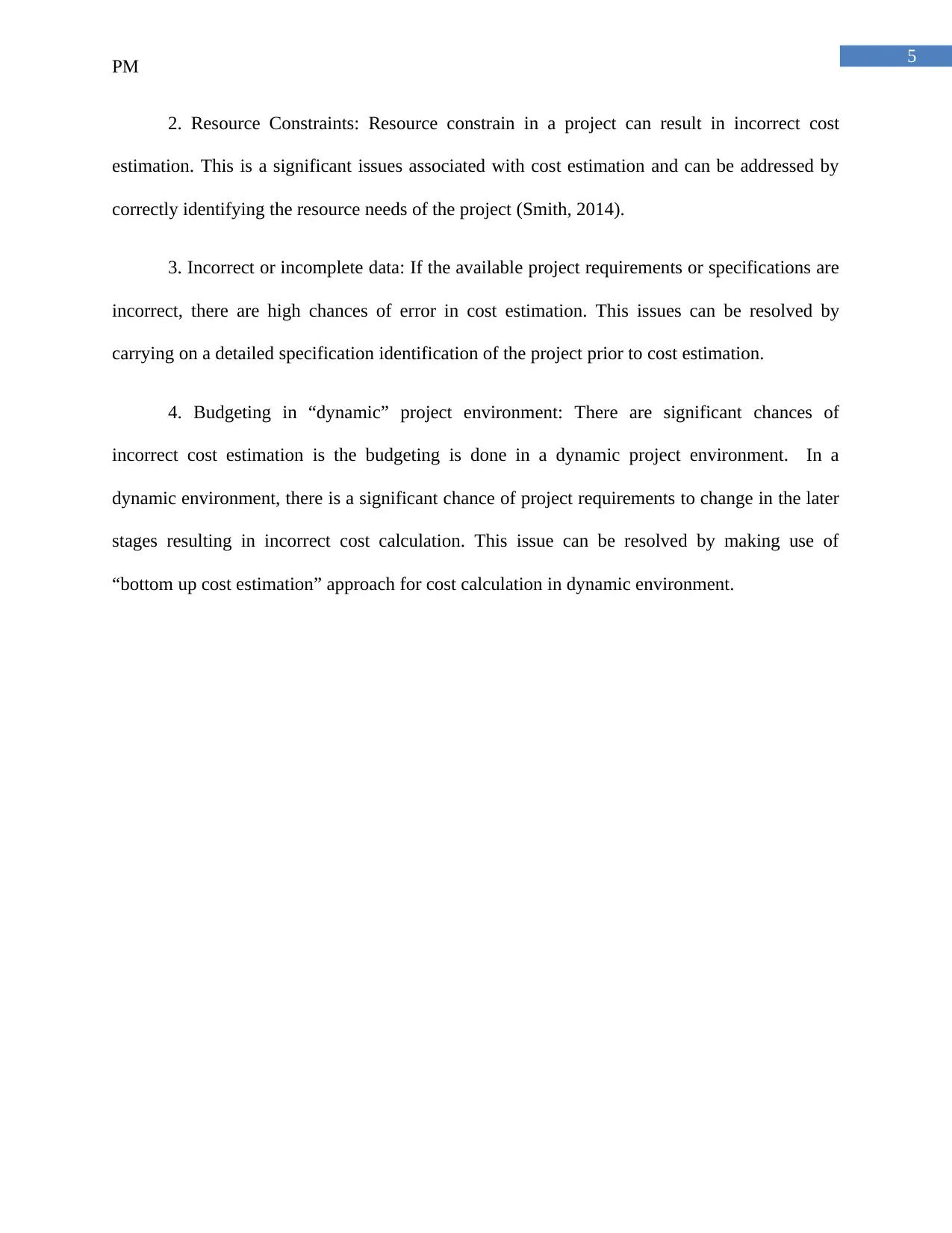
5
PM
2. Resource Constraints: Resource constrain in a project can result in incorrect cost
estimation. This is a significant issues associated with cost estimation and can be addressed by
correctly identifying the resource needs of the project (Smith, 2014).
3. Incorrect or incomplete data: If the available project requirements or specifications are
incorrect, there are high chances of error in cost estimation. This issues can be resolved by
carrying on a detailed specification identification of the project prior to cost estimation.
4. Budgeting in “dynamic” project environment: There are significant chances of
incorrect cost estimation is the budgeting is done in a dynamic project environment. In a
dynamic environment, there is a significant chance of project requirements to change in the later
stages resulting in incorrect cost calculation. This issue can be resolved by making use of
“bottom up cost estimation” approach for cost calculation in dynamic environment.
PM
2. Resource Constraints: Resource constrain in a project can result in incorrect cost
estimation. This is a significant issues associated with cost estimation and can be addressed by
correctly identifying the resource needs of the project (Smith, 2014).
3. Incorrect or incomplete data: If the available project requirements or specifications are
incorrect, there are high chances of error in cost estimation. This issues can be resolved by
carrying on a detailed specification identification of the project prior to cost estimation.
4. Budgeting in “dynamic” project environment: There are significant chances of
incorrect cost estimation is the budgeting is done in a dynamic project environment. In a
dynamic environment, there is a significant chance of project requirements to change in the later
stages resulting in incorrect cost calculation. This issue can be resolved by making use of
“bottom up cost estimation” approach for cost calculation in dynamic environment.
⊘ This is a preview!⊘
Do you want full access?
Subscribe today to unlock all pages.

Trusted by 1+ million students worldwide
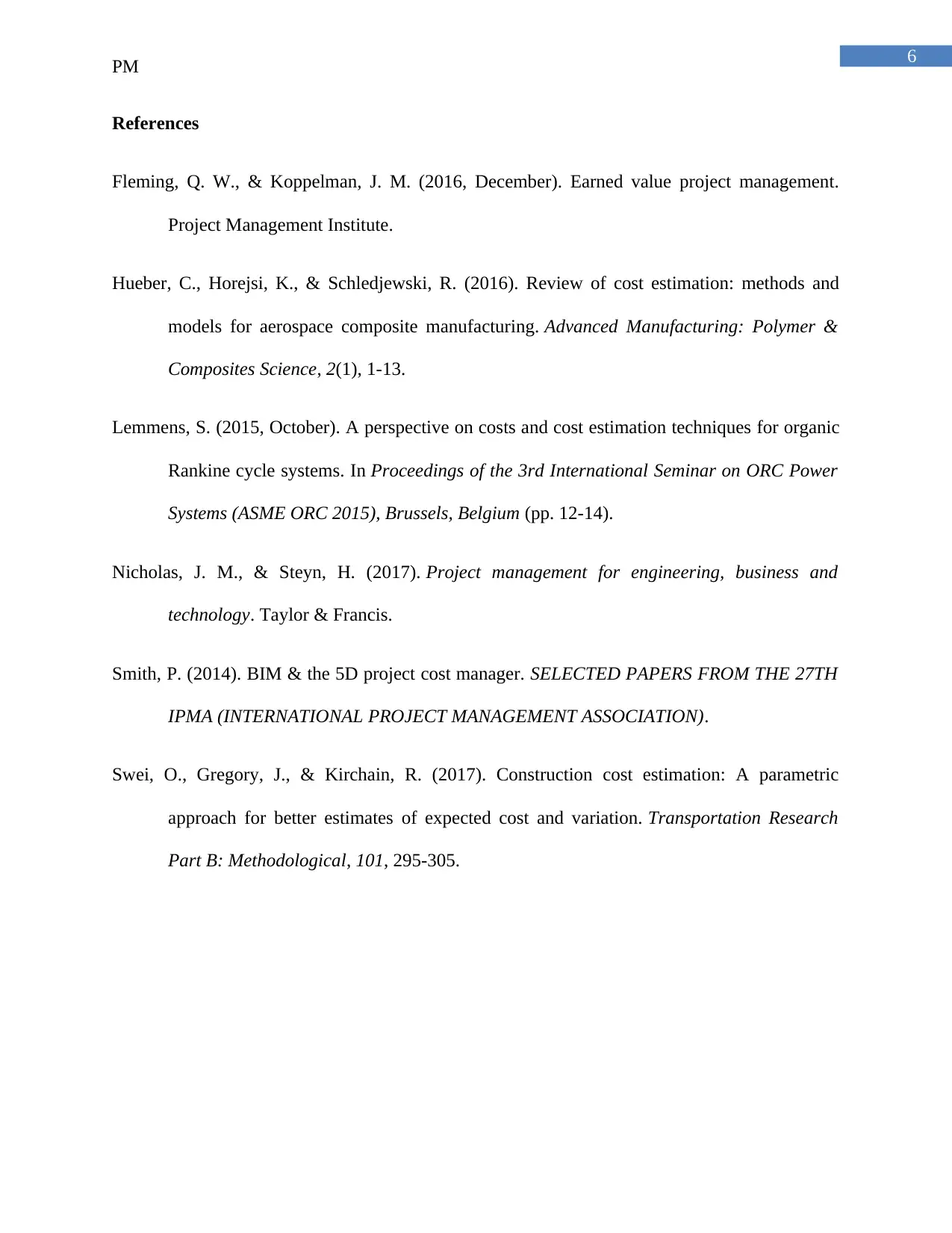
6
PM
References
Fleming, Q. W., & Koppelman, J. M. (2016, December). Earned value project management.
Project Management Institute.
Hueber, C., Horejsi, K., & Schledjewski, R. (2016). Review of cost estimation: methods and
models for aerospace composite manufacturing. Advanced Manufacturing: Polymer &
Composites Science, 2(1), 1-13.
Lemmens, S. (2015, October). A perspective on costs and cost estimation techniques for organic
Rankine cycle systems. In Proceedings of the 3rd International Seminar on ORC Power
Systems (ASME ORC 2015), Brussels, Belgium (pp. 12-14).
Nicholas, J. M., & Steyn, H. (2017). Project management for engineering, business and
technology. Taylor & Francis.
Smith, P. (2014). BIM & the 5D project cost manager. SELECTED PAPERS FROM THE 27TH
IPMA (INTERNATIONAL PROJECT MANAGEMENT ASSOCIATION).
Swei, O., Gregory, J., & Kirchain, R. (2017). Construction cost estimation: A parametric
approach for better estimates of expected cost and variation. Transportation Research
Part B: Methodological, 101, 295-305.
PM
References
Fleming, Q. W., & Koppelman, J. M. (2016, December). Earned value project management.
Project Management Institute.
Hueber, C., Horejsi, K., & Schledjewski, R. (2016). Review of cost estimation: methods and
models for aerospace composite manufacturing. Advanced Manufacturing: Polymer &
Composites Science, 2(1), 1-13.
Lemmens, S. (2015, October). A perspective on costs and cost estimation techniques for organic
Rankine cycle systems. In Proceedings of the 3rd International Seminar on ORC Power
Systems (ASME ORC 2015), Brussels, Belgium (pp. 12-14).
Nicholas, J. M., & Steyn, H. (2017). Project management for engineering, business and
technology. Taylor & Francis.
Smith, P. (2014). BIM & the 5D project cost manager. SELECTED PAPERS FROM THE 27TH
IPMA (INTERNATIONAL PROJECT MANAGEMENT ASSOCIATION).
Swei, O., Gregory, J., & Kirchain, R. (2017). Construction cost estimation: A parametric
approach for better estimates of expected cost and variation. Transportation Research
Part B: Methodological, 101, 295-305.
1 out of 7
Related Documents
Your All-in-One AI-Powered Toolkit for Academic Success.
+13062052269
info@desklib.com
Available 24*7 on WhatsApp / Email
![[object Object]](/_next/static/media/star-bottom.7253800d.svg)
Unlock your academic potential
Copyright © 2020–2025 A2Z Services. All Rights Reserved. Developed and managed by ZUCOL.





